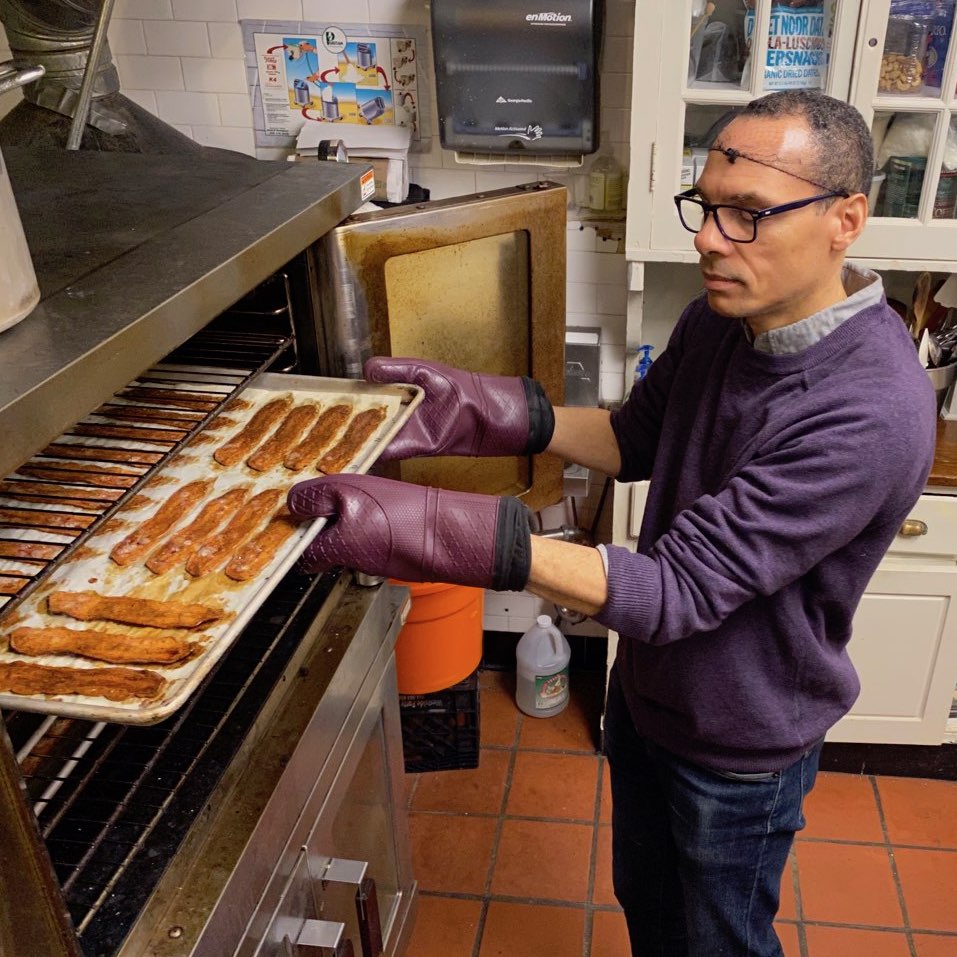Stories of These Times · March 24, 2020
The End-User Experience
"Thank you so much. Now I won't starve to death."
At the end of “PBS NewsHour” on March 13, anchor Judy Woodruff signed off with a personal statement to viewers, asking them to refrain from hoarding basic items like toilet paper and to look out for the most vulnerable in our communities—our elderly neighbors—during this time of crisis. I decided to reach out to my pastor. With the travel ban to Europe, and me stranded in New York while my wife and daughter are living in France, I asked if I could volunteer this past weekend.
I showed up for our Meals on Heels program, still operating every Saturday morning to prepare and deliver home-cooked meals to elderly and homebound neighbors. I took to chopping, peeling and crunching as I reconnected with friends and other volunteers in my hairnet and rubber gloves. A table was set up with 40 St. Patrick’s Day cards to put into each lunch bag, made a few weeks ago by elementary school kids from Brooklyn on a school trip to teach them about navigating the subway system.
I told one volunteer that at FIT last semester in my studio class I organized a group of nine 13-year-old kids from City Knoll Middle School to collaborate with my studio students on the design of pop-up shops that the kids would want to run as young entrepreneurs. Using design thinking, I taught my students how to fully immerse themselves in the research of the end users, by interviewing and being critiqued on their design solutions for t-shirt and sneaker retail spaces, by the very Gen Z population that would be their future clients. These kids challenged and demanded customizable experiences, services and products from my “expert” design students.
Back at Meals on Heels, I was handed my lunch bags of home-cooked food and set off to deliver to three elderly ladies in Greenwich Village. I entered the first (no-elevator) apartment building, huffing and puffing my way up six flights of stairs to deliver my first meal. “No wonder she’s homebound,” I thought as I handed her the bag from a safe distance, with my rubber gloves supporting the bottom so she could grab the handle herself. She was so grateful; she beamed as she took the bag. She thanked me and asked if I would take down her recycled glass and plastic. I said, “no problem” as I took the small plastic bag, thinking, “and you stay up here until they build you a damn elevator!”
My second lovely lady thankfully lived on the first floor. “Don’t come in!” she shouted through the half-open door. “I won’t,” I responded, as I stretched to hand her the bag. As I turned to leave, she asked, “Did you bring toilet paper?” I said, “No, I didn’t know you needed it.” “They’re all out at the store.” “Really? Would you like me to bring you some?” “Would you please? That would be so wonderful. If they have tissues, I’d take those instead,” she cried out.
I left on a mission—to find the toiler paper! A few blocks away I entered a small convenience store, grabbed two packs of four rolls and a large box of tissues, for good measure. “TWENTY-FIVE DOLLARS!” I shouted at the cashier. “That’s price gouging. I’m buying this for an elderly shut-in.” She responded, “That’s the price it’s always been, especially for the recycled brands.” “No way can toilet paper be that expensive,” I shot back. I fumed but had no choice. I was not going to spend the day looking for cheaper toilet paper.
I returned and handed over my Fort Knox haul. “Oh, you are such a dear,” she said as she opened the door wider, revealing an apartment in need of a major renovation. My architectural antennae went up. “How much do I owe you?” “No, no. It’s all right. It was 20 bucks. Don’t worry about it.” “Please, let me give it to you.” “Really, it’s OK. I don’t want your money.” She handed me $20 anyway and asked if it was enough. I graciously took it, said it was, and left. I’ll put it in the collection plate, once services resume.
My third lovely lady was in a doorman building. I rang the buzzer. No answer. I rang again. No answer. I knocked on the door. “Who is it?” “Meals on Heels.” “Who?” “Meals on Heels!” I said a little bit louder. “Who?” “MEAL ON HEELS!” She opened the door holding her cane and asked if I could put it on the kitchen counter. “Sure. No problem.” I entered, walked through the apartment to the kitchen and set it down. “Thank you so much. Now I won’t starve to death.” We laughed together. “Nope. Not today you won’t.”
I left feeling really good. My experience and the experience I brought to each lovely lady is what I teach my students. It’s about the end-user experience, no matter the product or, in this case, the service. It’s how we feel as a volunteer as much as it is about the person we are serving. The owners of the convenience store and their cashiers don’t get it. That day confirmed that I do.
I just may keep doing this for a while, or as long as I will be allowed. I’ll keep you posted. And you stop hoarding all the toilet paper. There are elderly people in need.

This story originally was published on Eric’s blog, thinkshift.